I listen a lot to Haydn quartets when working... easy yet stimulating to listen too.At last, I want to put in a musical plug for those wonderful Haydn's string quartets op. 20, which lately I have mentioned repeatedly when monitoring system improvements. The opus 20 number is misleading; Haydn wrote those quartets when he was already 40 years old and had written a ton of music before these works (including 40+ symphonies or so).
The Wikipedia page reads:
The six string quartets opus 20 by Joseph Haydn are among the works that earned Haydn the sobriquet "the father of the string quartet".[1] The quartets are considered a milestone in the history of composition; in them, Haydn develops compositional techniques that were to define the medium for the next 200 years.
[...] When Haydn published his opus 33 quartets, ten years after the opus 20, he wrote that they were composed in "an entirely new and particular manner".[14] But, if the opus 33 was the culmination of a process, opus 20 was the proving ground. In this set of quartets, Haydn defined the nature of the string quartet – the special interplay of instruments that Goethe called "four rational people conversing".[15] Many of the compositional techniques used by composers of string quartets to the present day were tried out and perfected in these works.
"This cannot be overstated," writes Ron Drummond; "the six string quartets of Opus 20 are as important in the history of music, and had as radically a transforming effect on the very field of musical possibility itself, as Beethoven's Third Symphony would 33 years later".[16] And Sir Donald Tovey writes of the quartets, "Every page of the six quartets of op. 20 is of historic and aesthetic importance... there is perhaps no single or sextuple opus in the history of instrumental music which has achieved so much".[17]
Here are some of the innovations of the quartets:
Equality of voices
Prior to opus 20, the first violin, or, sometimes, the two violins, dominated the quartet. The melody was carried by the leader, with the lower voices (viola and cello) accompanying. In opus 20, Haydn gives each instrument, and particularly the cello, its own voice. An outstanding example of this is the second quartet in C major. The quartet opens with a cello solo, accompanied by the viola and second violin. This was virtually unheard of in Haydn's time. Another example is in the slow movement of the fourth quartet, in D major. This movement is a set of variations, written in D minor; the first variation is a duet between viola and second violin, and the third variation is a solo for cello.
Here the Wikipedia page gives a note example from Op.20/4, showing interplay between the first violin and cello:
View attachment 74627
This is from the first movement of op. 20/4, about 50 seconds in. Here is an example of the music on YouTube, beautifully played by the Attacca Quartet (they also play the album release of "Orange" by Caroline Shaw):
The Wikipedia page continues with a list of other innovations that each are discussed:
Structural innovations
Depth of expression
Length and symmetry of phrases
Use of counterpoint
The entire page is a worthwhile read.
My monitor/subwoofer system
- Thread starter Al M.
- Start date
You are using an out of date browser. It may not display this or other websites correctly.
You should upgrade or use an alternative browser.
You should upgrade or use an alternative browser.
Beethoven’s and Schubert’s are better but demand full attention...Mozart’s are also pleasant for undemanding pleasure.I listen a lot to Haydn quartets when working... easy yet stimulating to listen too.
Which ones do you like? We have Kodaly complete set, Apponyi (our favorite and excellent), London Haydn QuartetI listen a lot to Haydn quartets when working... easy yet stimulating to listen too.
For Beethoven, we have been listening to Quartetto Italiano (full set) just this past week which were remastered nicely by Decca. Also have Takacs and Busch but prefer Quartetto Italiano best.Beethoven’s and Schubert’s are better but demand full attention...Mozart’s are also pleasant for undemanding pleasure.
For Mozart, we have Alan Berg and Fine Arts Quartet...have not listened in some time.
For Schubert, Quartteto again and also Lindsays for the late quartets.
You?
Beethoven’s and Schubert’s are better but demand full attention...
Haydn does too, if you listen seriously. It's very complex music, both in thematic treatment and musical flow.
I agree that Beethoven and Schubert are great, but so is Haydn.
Mozart’s are also pleasant for undemanding pleasure.
Again, wrong. Mozart's best string quartets, like his Haydn quartets (dedicated to that composer) are incredibly sophisticated music, and demanding to listen to.
I used to underestimate Mozart, not any longer.
Talking about Schubert, at the end of my musical evening tonight I listened to the late piano sonata in C minor D958, part of a trilogy of interconnected sonatas of which the B flat major sonata D960 is the most famous. Gorgeous music, just magnificent.
There is a fantastic, very detailed Wikipedia article on these sonatas,

 en.m.wikipedia.org
en.m.wikipedia.org
that also dives into the history of reception and how these sonatas were neglected during the 19th century -- just like Beethoven's late string quartets, by the way. Hard to believe nowadays.
Before that I was listening tonight to the wonderful opera The Nightingale by Stravinsky, with incredible melodies and instrumentation, and to two string quartets of the op. 20 cycle by Haydn. The density of just the first minute of op. 20/1 blows my mind, each time. So much going on.
So much great music to listen to, too little time for it all.
There is a fantastic, very detailed Wikipedia article on these sonatas,

Schubert's last sonatas - Wikipedia
that also dives into the history of reception and how these sonatas were neglected during the 19th century -- just like Beethoven's late string quartets, by the way. Hard to believe nowadays.
Before that I was listening tonight to the wonderful opera The Nightingale by Stravinsky, with incredible melodies and instrumentation, and to two string quartets of the op. 20 cycle by Haydn. The density of just the first minute of op. 20/1 blows my mind, each time. So much going on.
So much great music to listen to, too little time for it all.
You are reading things that I didn’t say. I made no comment about the complexity of either Haydn or MozartHaydn does too, if you listen seriously. It's very complex music, both in thematic treatment and musical flow.
I agree that Beethoven and Schubert are great, but so is Haydn.
Again, wrong. Mozart's best string quartets, like his Haydn quartets (dedicated to that composer) are incredibly sophisticated music, and demanding to listen to.
I used to underestimate Mozart, not any longer.
Mozart's best string quartets, like his Haydn quartets ... are incredibly sophisticated music, and demanding to listen to.
As are Beethoven's, particularly his last six.
You are reading things that I didn’t say. I made no comment about the complexity of either Haydn or Mozart.
Thanks for the clarification.
As are Beethoven's, particularly his last six.
Yes, I think all of Beethoven's quartets are amazing. The first six are exciting compositional marvels exemplary for the "classical" period but already in a distinctive voice, before Beethoven moved on to further expand the terrain.
Yes, I think all of Beethoven's quartets are amazing. The first six are exciting compositional marvels exemplary for the "classical" period but already in a distinctive voice, before Beethoven moved on to further expand the terrain.
His last six are anything but exemplary of the classical period. Hesitant about their public performance, B feared they would not be understood - "... they are not for you but another age" he replied to critics.
Beethoven’s and Schubert’s are better but demand full attention...Mozart’s are also pleasant for undemanding pleasure.
Perhaps more inviting to your attention are Mozart's String Quintets. There, another viola is added to the standard quartet and each instrument is offered opportunities not always found in his quartet music, with the violas not always consigned to the rhythm section.
I like these:
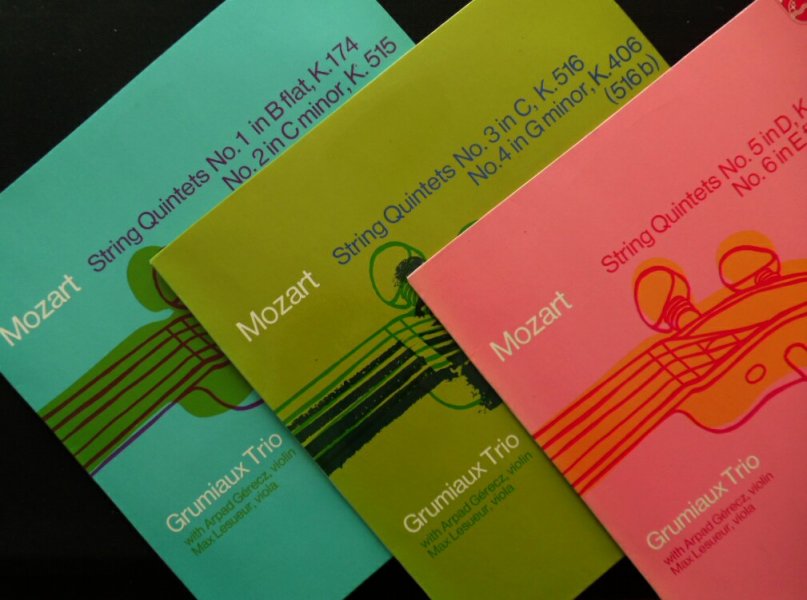
Philips 6500 619, 6500 620, 6500 621
or as a box set Philips 6747 107 - 3LP
His last six are anything but exemplary of the classical period. Hesitant about their public performance, B feared they would not be understood - "... they are not for you but another age" he replied to critics.
Yes, they are firmly transitioning into the romantic period (yet are highly individualistic at that), even though it might be argued that the nucleus for that was laid already in Beethoven's Third Symphony, written some 20 years earlier, in 1805.
Schubert's last musical wish was to hear [string quartet] Op. 131, which he did on 14 November 1828, five days before his death.[12] Afterward, he remarked, "After this, what is left for us to write?"[13]
From:

Late string quartets (Beethoven) - Wikipedia
Schubert's own three last piano sonatas, written in 1828, one year after Beethoven's death, clearly are already highly romantic, arguably even more so than even Beethoven's last three piano sonatas, written a few years earlier, between 1820 and 1822. Beethoven wrote his set of six last string quartets after that.
It would be interesting to have more insight into timelines for the transition from the classical to the romantic period, and who influenced whom.
Result as usual after cleaning of all my signal cables (analog and digital interconnnects, speaker cables) and connections: Yet again significantly less distortion, especially in the highs. Human voices sound purer, and the overall sound may be slightly more open as well.
I should add that after DeOxit D5/G5 contact cleaning there is also considerably better musical flow (this one's for Ked
Yes, they are firmly transitioning into the romantic period (yet are highly individualistic at that), even though it might be argued that the nucleus for that was laid already in Beethoven's Third Symphony, written some 20 years earlier, in 1805.
That is a very interesting opinion Al. Mine is more traditional - that Beethoven's final six string quartets skip over the romantic period almost entirely.
That is a very interesting opinion Al. Mine is more traditional - that Beethoven's final six string quartets skip over the romantic period almost entirely.
I might agree on the Grosse Fuge op. 133, which Stravinsky described as "an absolutely contemporary piece of music that will be contemporary forever."
Not the other ones though.
It would be interesting to have more insight into timelines for the transition from the classical to the romantic period, and who influenced whom.
I got alot out of listening to Primephonics "Ludwig" series (same as their "Essentials" for subscribers I think). I'm no musicologist, and found it really interesting who influenced whom, and when. As an aside I also have enjoyed their "Maestro" albums, which give notes to each track as they are played with the history of each composer in the context of the work.
I can also recommend "Classics Unlocked" a podcast by Graham Abbot.
Hope these assist.
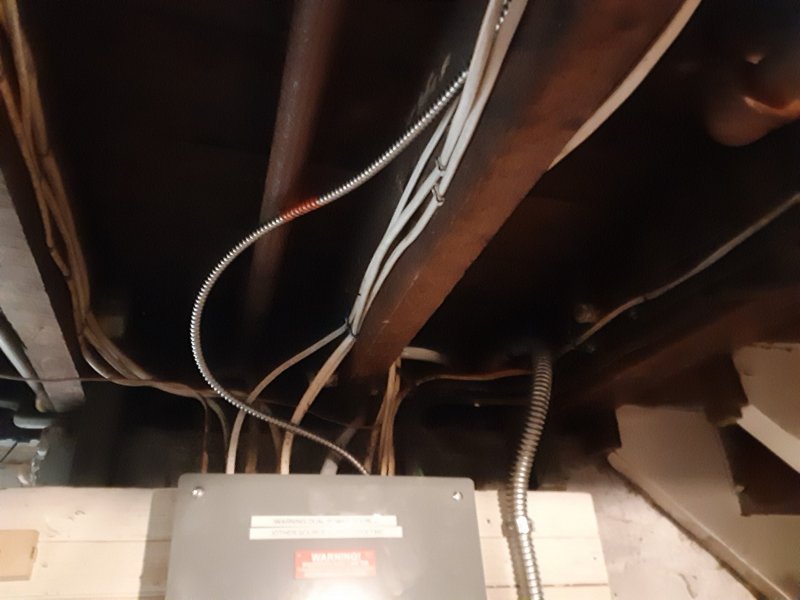

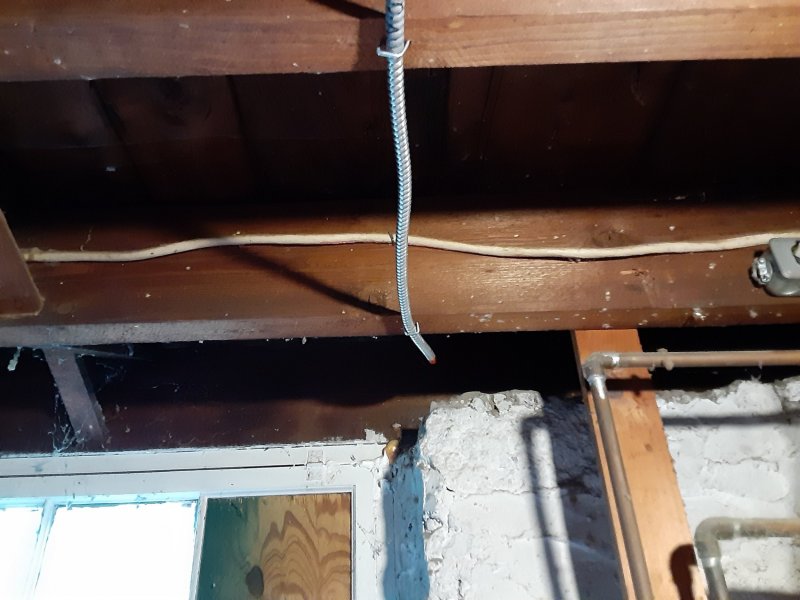
As I had already reported on another thread, I had for my system a dedicated 10 AWG power line from breaker box to outlet installed, to replace the standard 12 AWG line. It's 10/2 MC cable; that shielded cable was recommended by an audio buddy of ours who is an expert on electrical installations.
Above pictures show:
First picture: cable coming out of breaker box (on top) to go through basement ceiling (the other, much thicker, shielded cable to the right is the main cable to breaker box)
Second picture: part of the 10/2 MC cable along the basement ceiling
Third picture: Going from basement into the wall with the outlet to the music system
Outlet from wall is Shunyata:

SR-Z1 Outlets - Shunyata Research
Measuring power line noise with the TriField EM100 at the outlet yielded 39 mV peak-to-peak (mVp-p) one day, 40 another other day, down from 90. The electrician also exchanged the kitchen dimmer light switch to a regular on/off (with transformer ripped out). The reading with kitchen light on went, instead from previously 90 to 110, from 39 to 39. All that with second floor air conditioning blasting.
Sonically, two major benefits:
1. A considerable reduction of distortion; Ian (MadFloyd) said that would be the case and he was right. On a lot of material the sound became much cleaner than I had hoped for with my system.
2. Much better bass, tighter and more tuneful (better pitch definition). On one track where I had to turn off the subs because the bass was overloading the room, I can now leave the subs on and they play through the track wonderfully. I guess previously they lost control as they were starving for current.
The first two days the system sounded on some material like sand paper (Ian predicted lack of listenability as well), but then it became smooth and clean.
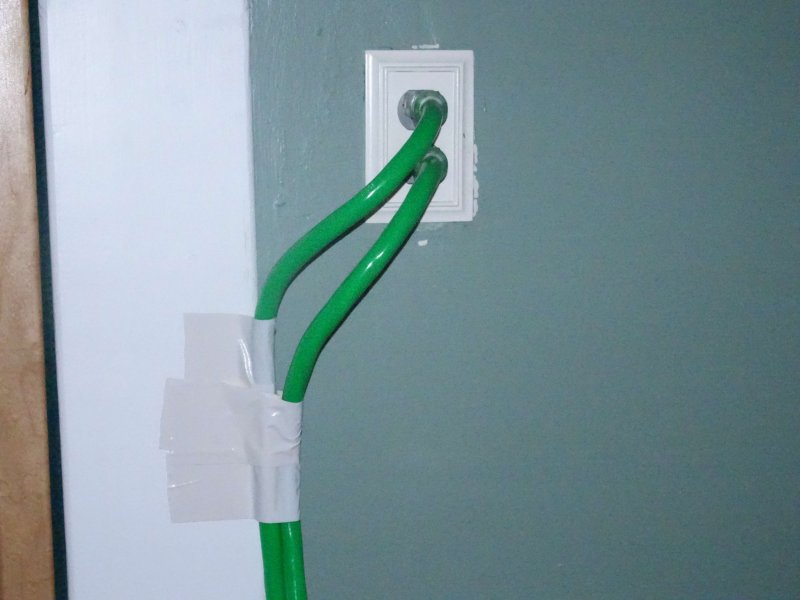

Vlad (VLS) thankfully kept repeating to me his suggestion to use 10 AWG not just for the line from breaker box to outlet, but for power cords as well. I didn't want to start with an audiophile cord that I had not auditioned and instead wanted to see what happens on the cheap. So I bought two 10 AWG extension cords to replace my single 12 AWG extension cord, total cost 45 bucks.
Each cord also has a splitter (see second image above), unlike with my previous configuration where I had extra splitters downstream of my extension cord. Thus, I don't have to introduce extra electrical connections beyond the connection between extension cord and component power cord. I need 6 outlets, and with the two extension cord/splitters I have 2 x 3 outlets. Extra electrical connections introduce more resistance; the Shunyata outlet for example is brass, which only has 28 % of the conductivity of copper (which unprotected would corrode where it would be exposed to air, which is probably why it is not used for outlets). Extra connections also apparently can introduce noise.
I put the two isolation transformers and power amp on one extension cord, and the preamp and two subs on the other cord.
There is one passage where I can hear a clear difference with my previous configuration with the single 12 AWG extension cord (but with the 10 AWG line from breaker box to outlet already in place). On Art Pepper + Eleven, track 7 (Bernie's Tune), there is a sudden dynamic rise in the playing of the alto sax at 0:44:
(on the Youtube video you don't hear that much of the dynamics, but it gives you an idea about the music)
The dynamics of that had sounded excellent, even explosive, on my system, but at the same time the sax got thinner and screechier as it got louder. Now the tone does not change, just the dynamics. That's a big improvement. I know this passage on my system very well, and I have never heard it this good -- reproducibly. So I am confident that this is a real change introduced by this new configuration of 10 AWG extension cords/splitters from the outlet, for the better.
I have also changed the 14 AWG cord of my power amp to a 7 AWG Pangea audiophile cable that I had lying around, but interestingly this does not lead to further improvement. Just to be sure, I left the 7 AWG power cable in the system for further (re-) burn-in and will after a while return to the 14 AWG cord to see if it still makes no difference.
Last edited:
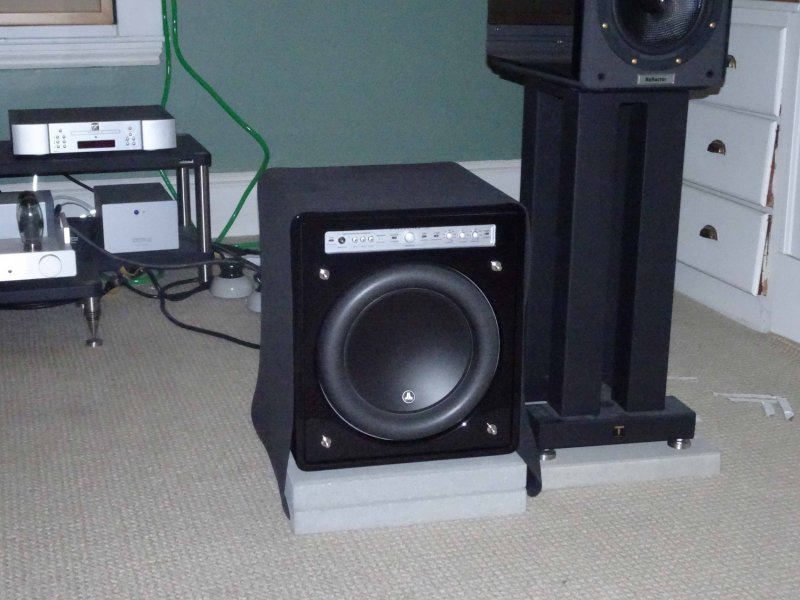


Last winter I had reported that covering the chassis of the sub with rubber blankets greatly reduced distortions, because it took away overly reflective surface presented by the gloss paint.
I had still worried somewhat about the gloss paint surface left on the front baffle of the subs (see uppermost photo), but since this a far lesser amount of reflective surface than the sub chassis, I had not taken the issue seriously enough.
Yet after again hearing Ian’s (MadFloyd’s) very distortion-free system I began to look for any still remaining areas of possible lowering of distortion in mine. So the subwoofers once more came to my mind. I finally decided on the simplest solution even though initially I had not favored it aesthetically, which is to put the front covers in place. As you can see from the pictures, however, it is actually quite nice not to see the subwoofer drivers, and in contrast have only the main speaker drivers exposed. Given that the subs only provide bass frequencies, the front covers have no obvious audible impact on the sound, very much in contrast to main speaker covers that affect the midrange and, in particular, the treble.
What is the result? Despite the comparatively minor reduction of reflective surface around the range of close-up radiation by the speakers, there was again clearly audible further reduction of distortion, especially in the upper midrange and treble. An acid test are for me always the very overtone rich timbres of string quartets played on period instruments with their gut strings (these recordings tend to reveal distortions upon playback much more readily than string quartets played on modern instruments). Yet also on some saxophone recordings I heard less distortion. All this was clear since I know all those recordings and the distortions that I hear from them very well.

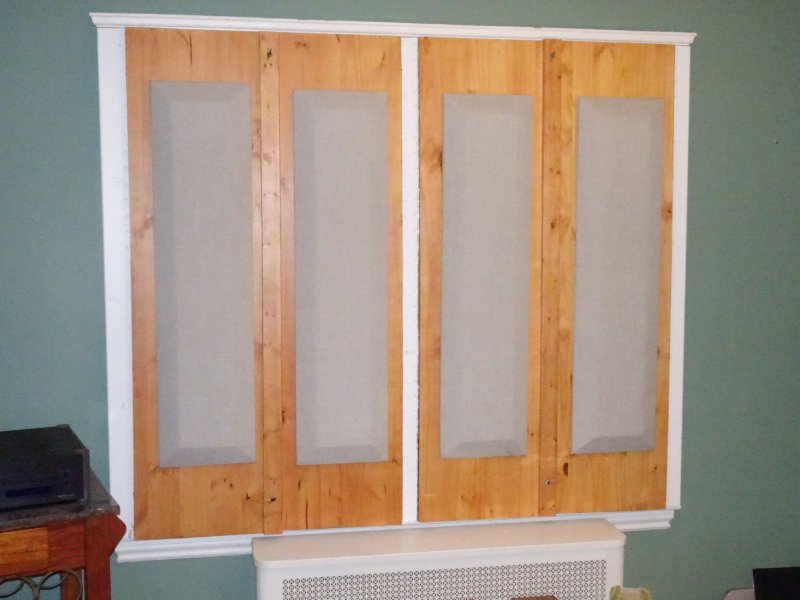
Before (above) and after (below); reflections are from camera flash.
Finally, above described positive finding made me motivated enough to tackle a problem that I had known for a long time to exist, but which I had always been too lazy to address because of the work involved. It is about the window shutters in the back of the room (and on the left hand window towards the back). Already a good while ago I had mentioned on this thread the highly reflective gloss paint on them that had been a literally glaring mistake. The shutters in the back are about 9 feet from the listening seat, and 17 feet from the speaker drivers (my room, while quite narrow at 12 feet, is rather long at 24 feet). Given those distances, my reluctance to do work on the shutters had not been helped by incredulity about such far away reflections possibly having a very pronounced effect on the sound, an incredulity shared by someone else in a private conversation after I reported on my findings following the finished work. Yet from my own experience I should have known better, since I knew that partially covering up the surface with ASC diffuser panels had had a positive effect, already a few years ago by now.
After I had raised concern on this thread about the shutters in January this year, Milan (Lagonda) said that he had covered up the window plugs in his room with wall paper. After some initial enthusiasm about the suggestion (thanks, Milan), I decided that I did not want permanently glued paper on my wooden shutters, and less fixed solutions with just tape did not work out since they gave no smooth surface. I was also not quite thrilled with the aesthetic choices available.
So finally I returned to my original plan to cover the gloss paint with matte paint (see above pictures, now and then). Fortunately this new polyurethane paint is water-based, with minimal odor development. With paint that is based on organic solutions I would rather have "evacuated" my system; I don't want any vapors to get into the gear. Removing the shutters for painting in another room, and then re-installing them, would have been cumbersome and impractical; they are also extremely heavy since the outward facing side is covered with mass-loaded vinyl for noise isolation. Now with the water-based paint I just painted while letting a fan run to push air out of the room until the paint was dry. The work was much less of an effort than I had anticipated.
The result is stunning. There is another level of reduction of distortion that appears to rival the recent change from my previous 12 AWG line from breaker box to the outlet for my system to a 10 AWG line. I checked and re-cheacked problematic passages over a few days’ time, but my first impressions of a great effect on cleaner sound only became confirmed.
Before I go into more details, I want to answer a question that by now the patient people may have who are actually reading these pages. Why is a majority of posts the last few months about reduction of distortion, again reduction of distortion, once more reduction of distortion and so on? How much distortion must have there been in the first place, and how low can it go?
Several things:
1. First, obviously my room has lots of problems with uncontrolled and detrimental reflections, a fact that is confirmed with every improvement to mitigate this issue. The reflection problems are emphasized by the not so large size of the room, and by the relatively high volume at which I listen, e.g. peaks on orchestral music and some jazz at about 95 dBa (ca. 100 dB) and on string quartets at about 90 dBa (ca. 95 dB) – I like to listen to string quartets at levels that somewhat approach a living room concert. All this of course while still trying to adhere to NIOSH recommendations for daily sound level exposure; average levels on these types of music are considerably lower than peak levels (and to more constantly loud rock music I listen at lower levels). Were I to listen at just 5 dB lower average levels, detrimental reflections would play a disproportionately lesser role.
2. Most importantly, however, the more distortion from reflections or other things is reduced, the more I become sensitive to what is left of it. That sensitivity becomes more as time passes, until I take the next measure. That is a natural process, somewhat analogous to the sensitization that audiophiles experience as they upgrade their gear and it becomes more revealing, and they gradually realize how much things can be further improved with yet another upgrade, which often leads to the well-known merry-go-round.
3. There is also some music that I would like to listen to more loudly, and as I can crank it up just a tiny bit more as the sound improves, remaining problems become more evident that then beg to be addressed. In particular, some of the period instrument string quartets I am now able to listen more loudly to. Just this week I listened again to my cherished CD of Eybler quartets by the Eybler Quartet, music that I described on another WBF thread), but now at peak levels of 88 dBa (more than 90 dB).
(cont.)
Similar threads
- Replies
- 47
- Views
- 5K
- Replies
- 5
- Views
- 748
- Replies
- 8
- Views
- 4K
- Replies
- 6
- Views
- 748
| Steve Williams Site Founder | Site Owner | Administrator | Ron Resnick Site Owner | Administrator | Julian (The Fixer) Website Build | Marketing Managersing |

